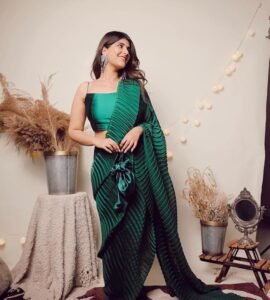Let the heritage endure! India, deeply rooted in collectivism, is renowned for perpetuating its cultural values and lifestyle norms, especially in the realm of attire. In the regions of Gujarat and Rajasthan, a wedding tradition has persisted for centuries, where the bride enters her new home adorned in a checkered and lavishly ornate sari.
This traditional attire, known as Gharchola, remains a significant element of the bridal ensemble to this day. In Hindu and Jain cultural customs, the mother-in-law presents this saree to her new daughter-in-law for the wedding ceremonies.
Characteristics of a Gharchola Saree
An authentic Gharchola saree is crafted from Venkatgiri cotton, possessing a glossy surface akin to silk. Gaji silk is also a favored fabric for creating these artistic drapes. The saree’s length is divided into grids, each colored using the Bandhani tie-and-dye technique. It is intricately woven with genuine gold or copper zari threads, rendering it highly valuable. The garment is further embellished with handwork such as thread embroidery, cutdana, diamonds, beads, and stones, making it a captivating choice for bridal wear.
Due to its auspicious significance, shades of red, maroon, green, and occasionally yellow dominate the color palette of these sarees. The grid or checkered pattern is a distinctive feature of Gharchola sarees, which are typically segmented into 9, 12, or 52 squares, with the 12-grid variant referred to as ‘baar bhag’ and the 52-square version as ‘bavan bhag.’
Modern Transformations
As cultures evolve, adjustments are made to align with changing lifestyles. Traditionally, a Gharchola saree was draped over the bride’s head, but in contemporary times, it is worn as a regular Gujarati pallu drape. The manufacturing process has also adapted to cater to the budget preferences of modern brides who prioritize practical and economically priced wedding attire.
Consequently, Gharchola sarees are now produced on power looms using Gaji silk as a base, and Bandhani motifs are incorporated through digital prints. The use of plastic zari further reduces the overall cost, making Gharchola sarees an affordable option for brides.
Beyond the Wedding
With its intricate details, this traditional bridal attire has transcended into the realm of casual sarees and contemporary drapes. Gharchola prints are now employed in crafting trendy designer sarees in vibrant hues.
The Red and Green Color Palette
While the manufacturing and draping styles of Gharchola sarees have evolved, the auspicious shades of red and green persist, resisting replacement by contemporary pastel hues in bridal wear. Gharchola sarees, with their timeless details, continue to be a part of wedding ensembles for modern brides, even those situated globally.
The enduring charm of these sarees, with their auspicious colors, Bandhani motifs, and precise grids adorned with golden borders, reflects the deep-seated essence of Indian culture, ensuring their continued presence in the decades to come!
